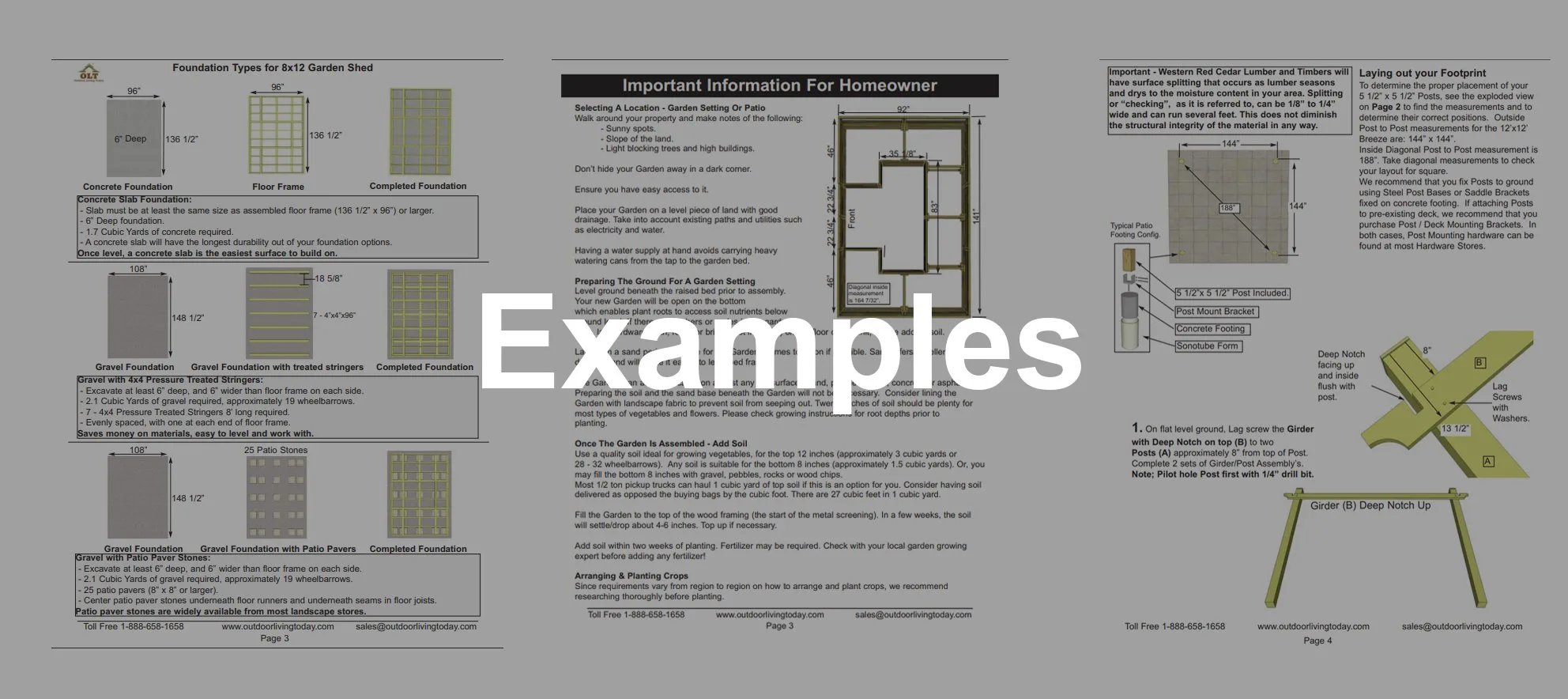No products in the cart.
Site Prep
Proper site preparation is paramount when installing sheds, gardens, gazebos, playhouses, or pergolas. Thoroughly evaluating the site ensures the structural integrity and longevity of these outdoor additions. Clearing the area of debris, leveling the ground, and assessing soil drainage can help prevent potential issues in the future. Adequate site preparation helps prevent water accumulation, which can lead to premature rot and damage. Additionally, it ensures a stable and level foundation, avoiding structural instability.
Investing your time in proper site prep before starting a project ensures your product will be a safe, long-lasting, and visually appealing investment for many years to come.
Please note: Certain counties and municipalities require building permits prior to installation. We recommend to all consumers that they check with their local county/municipality for these specifics prior to purchasing any of our products since this is your sole responsibility.

General Site Prep
Please download and review the specific Assembly Manual for the product that you have purchased, or are thinking of purchasing from our website for the most accurate and up-to-date information regarding that units recommended site preparation.
(Examples below can be found on Page 3-5 of the Assembly Manual)

Recommended Foundation Options & Procedures
Concrete Foundation:
A concrete foundation is a superior choice due to its unparalleled strength, durability, and longevity. It provides a stable and solid base for any structure, ensuring structural integrity and resistance to various environmental factors. Begin by preparing the site, ensuring it's level and compacted. Install formwork to outline the slab's dimensions, using lumber and stakes to maintain the structure. Next, lay a gravel base and a moisture barrier to prevent water seepage. Mix concrete thoroughly, combining cement, sand, and gravel in the correct proportions. Pour the concrete into the formwork, leveling and smoothing the surface using a screed and float. Allow ample time for curing and drying, ensuring the slab's strength and durability. A well-executed concrete slab provides a reliable foundation for any building endeavor.
Here is a detailed video example from a previous customer
Gravel Foundation:
A gravel foundation offers several advantages, including cost-effectiveness and ease of installation. It promotes drainage, preventing water-related issues and minimizing soil erosion. Gravel's permeability also helps in preventing moisture buildup, thus safeguarding structures from potential damage. Start by preparing the site, clearing it of debris, and ensuring a level surface. Install formwork to define the slab's boundaries, using stakes and boards. Spread a compacted layer of gravel evenly within the formwork, providing adequate thickness for stability. Use a hand tamper or mechanical compactor to achieve proper compaction and uniformity. Verify that the slab remains level even throughout the process a gravel base provides excellent drainage, minimizing the risk of water-related damage and serving as a dependable foundation for structures like sheds, walkways, or patio areas.,
Patio Stone Foundation:
A patio stone foundation is an excellent choice due to its aesthetic appeal and versatility. It adds a touch of elegance to outdoor spaces while providing a stable and level surface for furniture and foot traffic. Firstly, mark the patio's perimeter, ensuring the area is level and compacted. Excavate the site to the required depth, removing any unwanted material. Lay a landscape fabric to prevent weed growth and aid in drainage. Add a layer of gravel and compact it thoroughly to create a stable foundation. Arrange the patio stones in the desired pattern, leaving uniform gaps for jointing sand. Fill the gaps with fine sand and sweep it into place. Tamp the stones down to ensure a solid, level surface. A well-built patio stone base guarantees a beautiful and durable outdoor living space.
Pressure Treated Beam Foundation:
A pressure-treated beam foundation is a smart choice for its exceptional resistance to decay and insect damage. The treatment process extends the lifespan of the wood, ensuring long-term durability and stability for structures. Begin by excavating the site and leveling the ground. Install concrete footings at strategic points, allowing them to cure. Place pressure-treated wooden beams horizontally on top of the footings, ensuring they are level and adequately spaced. Secure the beams with metal brackets or galvanized nails. Add additional beams and cross-bracing for enhanced strength and stability. This foundation type is ideal for sheds, small cabins, or decks, offering resistance against rot, decay, and insect damage. A well-constructed pressure-treated beam foundation ensures longevity and durability for your structure.
For more detailed information on how to pour your concrete-slab foundation or any other questions regarding specifications, foundations, and permits, please call our Customer Support Line at 1-888-658-1658 to speak with a Product Representative.







